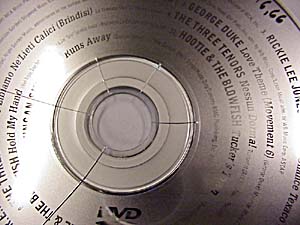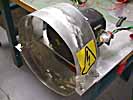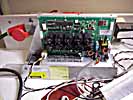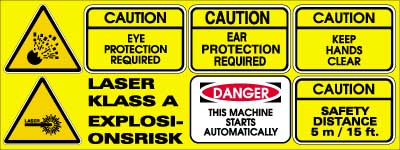
At medium speeds the subsrate cracks, redering the disk unplayable
|
Introduction |
References |
If a DVD record spins too fast in its drive it might blow up into thousands of little plastic splinters leaving the drive with the speed of a bullet. Don't sit in the way.
CD-ROMs could be hazardous to your health, and DVDs even more so. At too high rpm's they blow up with a bang and could in the worst case cause injury to persons. Reader manufacturers are trying to overshadow each other all the time with higher speed factors (factor “X”) but there is a limit that cannot be transgressed: the plastic's tensile limit. Unfortunately, some manufacturers have already passed it and we have had e-mails from many on the Internet who have experienced fractured disks. Earlier experiments have shown that shrapnel is capable of tearing up holes in the roof and crack aluminium sheet. With such power, a trouser-leg is no problem. This is a potential consumer problem waiting to happen to many buyers of a new generation of players.
“It just said bang...”, “Can I quote your article in a court case against Microsoft...” and similar, have been in the e-mails. The final proof that our research has a function to fill for humanity was when my previous article was slashdotted (noted on the Slashdot news service) in the beginning of 2002 and took down my web server.
Since our last scientific venture, DVD and DVD-RAM media have become common, and the research committee decided to run a new series of tests. At this point in time (November 2001) there are 16X DVD drives available, and 24X is around the corner. In the inner track a 16X DVD (26,528 rpm) is already at the tensile limit.
As the disk spins up the centrifugal force increases, pulling the outer parts of the disk outwards. This increases the loading near the hub so that the hub diameter starts to increase. Finally, radial cracks start to appear in the hub and the disk separates into pie slices. In the case of the CD-ROM the failure is catastrophic. At 27,000 rpm the disc is fragmented into millimetre size shrapnel flying off in the direction of the tangent (everywhere) at 170 metres per second, half the speed of sound. The DVD has a tough substrate that can take higher speeds, but it cracks at the hub at 26,000 rpm anyway. DVDs are finally blown apart at 30,000 rpm, but the shrapnel are centimetre-long and sharp, like knives. The periphery of the disc is subjected to more than 1500 g at 30,000 rpm and the hub is loaded with a tension of 35 N/mm2 on the inner surface. It is this force that will finally break up the disk. The shrapnel, that can easily deform one-millimetre aluminium, will break through the reader's front cover, and through your pants, too. Normally, the hub of the DVD will stay on the spindle after the explosion, because it is stronger than the rest of the disk.
But why aren't disks blowing up all the time? There are multiple reasons: the readers usually don't read as fast as the manufacturer boasts, because the reading errors increase with increasing speed and increasing vibrations. The drive cannot use full speed. Also, p-CAV (partial CAV) is often used, meaning that the drive runs at the labelled speed factor until some critical value is achieved, and then backs down to some lower speed. That a 48x reader actually reads at full speed is unusual. You will quite often hear how the reader accelerates to full speed and then reduces the speed as the reading errors increase.
During our continuing work with destructive testing of various media, test objects in the form of 120 and 80-mm DVD records were provided. We got two types of disks, with and without “Hardcoat”. The exact function and formula of the “Hardcoat” was unknown to us, and will be discussed below. The aim of the test was to determine the speed at which optical memory disks will blow up because of internal tensile failure. The test used a three-phase motor whose speed was controllable with great exactitude. The waveform of the driving current was controlled with great precision to make sure all the test objects was exposed to the same stresses.
DVD disks differ from CD-ROM and CD-R in that they have a strength layer laminated with a playable substrate. A CD-ROM has only one layer made of acrylic plastic.
For the sake of comparison and for calibration reasons we included a few CD-ROM and CD-R disks in the test.
All disks were subjected to the same speed ramp of 60 rpm/min/s (2 Hz/s on the 3-phase input voltage). During this test run we applied a very good standardisation of the testing procedure, virtually eliminating material fatigue from the test results.
We were not able to blow up the 80-mm disks provided, as our motor wasn't capable of the speed required. We estimate the destruction speed for these disks to be somewhere in the vicinity of 45,000 to 50,000 rpm (32 - 40x). We are looking for a faster motor, and will return later with the results.
 |
The shrapnel protection around the test setup is heavily damaged. It could have been your leg. |
 |
For testing, a controllable three-phase generator with spluriser circuits was employed. |
DVD records fare much better than CD-ROM (approximately 28,000 - 32,000 rpm for DVD versus 23,000 for CD-ROM), but the playable substrate will crack at about 27,000 rpm because of stretching of the strength layer, rendering the disk unplayable after it has reached some 25 - 26,000 rpm (approximation). The DVD layers separate at higher speeds because of their different tensile properties.
The results table shows the electrical power input to the drive electronics for the various disks at various speeds. The red cells indicate the real destruction speeds for the tested disks. It is obvious that DVDs can stand much higher speeds than CD-ROMs.
The values in the table are absolute maximum values. We recommend a large safety margin, especially as the spreading of the values is significant.
We could not determine whether the “Hardcoat” had some real significance in the results, but we want to make a reservation against this, as the results are not statistically significant. Mass testing would yield more reliable results. One might note that the disk faring best did not have “Hardcoat”.
After the conclusion of the tests, the committee wants to propose the following safety precautions.

The committee is well aware of the consequences of these recommendations for the end consumer, so to say in the TV couch. It may be the responsibility of public health institutions, such as the National Board of Health and Welfare to regulate whether DVD players and computers should be put in a protected place, such as behind the sofa or in the bathroom, while the film is viewed, and to require all the family members to wear hearing protectors and goggles at all times. Strong headphones made of glass fibre may well function as hearing protection while at the same time giving a better stereo perspective. The fashion industry is innovative and will probably, within a very short time develop modern, protective clothing for the fashion-minded computer user, made of Kevlar or some other strong and light material.
The tests were carried out at Harad Labs at Atlas Copco Controls and we pledge gratefulness to the witch doctor of speed regulation, Thord Nilson, who also wrote the test software for the testing computer.
The table below shows all the tested objects. All the DVD records were kindly provided to us by Warner Media
(disks 2, 3, 4, 7 and 8). All other disks were used for reference.
|
Imput power (Watt) at speed (rpm)# |
|||||||||
| Object Number | Description |
Weight, g |
15,000 |
18,000 |
21,000 |
24,000 |
27,000 |
30,000 |
~33,000 |
|
CD 1 |
CD-R, Verbatim Datalife Plus |
16,09 |
354 |
400 |
464 |
23,100 |
|||
|
CD 2 |
DVD, Warner Music |
16,50 |
356 |
400 |
471 |
578 |
715 |
27,150 |
|
|
CD 3 |
DVD, WAMO Hardcoat |
16,37 |
355 |
399 |
469 |
575 |
719 |
28,830 |
|
|
CD 4 |
DVD, 8- mm test disk |
6,93 |
339 |
372 |
423 |
501 |
606 |
762 |
1030 |
|
CD 5 |
CD-ROM, Russian Quark Xpress |
15,33 |
346 |
391 |
458 |
23,940 |
|||
|
CD 6 |
CD-ROM, Photodisc |
15,23 |
342 |
388 |
460 |
21,300 |
|||
|
CD 7 |
DVD, Warner Music |
16,66 |
340 |
383 |
463 |
554 |
686 |
892 |
32.160 |
|
CD 8 |
DVD, WAMO Hardcoat |
16,37 |
338 |
? |
451 |
553 |
682 |
891 |
30,000 |
| Comments | |
|
# |
Power input to testing device |
|
|
Blew up at noted speed |
|
|
Blew up after 25 seconds at 30,000 rpm |
|
|
Survived testing |
|
? |
Data unknown |
Because these articles are the most popular I have ever written, here is a page with people's comments.
Here is the previous article, about exploding CD-ROMs.
Photo: Thord Nilson